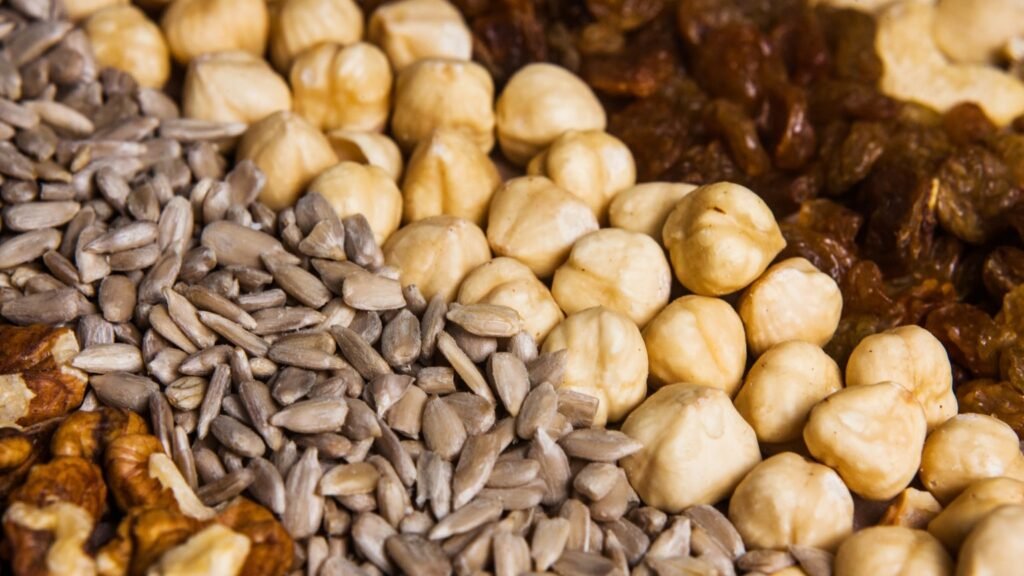
Omega-3 fatty acids are essential fats that provide numerous health benefits, including improved heart health, brain function, and reduced inflammation. While fish and seafood are often considered the richest sources of omega-3s, nuts also offer a plant-based alternative, particularly for vegetarians and vegans. However, not all nuts are equally rich in omega-3s — some contain significantly higher amounts than others.
In this article, we’ll explore the different types of nuts, rank them based on their omega-3 content, and discuss how incorporating them into your diet can boost your overall health.
What Are Omega-3 Fatty Acids?
Omega-3 fatty acids are polyunsaturated fats that the body cannot produce on its own, meaning they must be obtained through diet. There are three main types of omega-3 fatty acids:
- Alpha-linolenic acid (ALA) – Found primarily in plant-based foods like nuts, seeds, and leafy greens.
- Eicosapentaenoic acid (EPA) – Found in fatty fish and some marine algae.
- Docosahexaenoic acid (DHA) – Also found in fatty fish and algae, important for brain and eye health.
While nuts primarily provide ALA, the body can convert some ALA into EPA and DHA, though the conversion rate is relatively low (approximately 5%–10%). Still, including nuts rich in ALA in your diet can offer valuable health benefits.
Health Benefits of Omega-3 Fatty Acids from Nuts
Omega-3 fatty acids, particularly alpha-linolenic acid (ALA) from nuts, offer a wide range of health benefits.
One of the most significant advantages is improved heart health, as ALA has been shown to lower triglyceride levels, reduce blood pressure, and decrease the overall risk of heart disease.
Omega-3s also support brain function by enhancing cognitive performance and potentially reducing the risk of age-related mental decline. Their anti-inflammatory properties make them beneficial for managing conditions such as arthritis and autoimmune diseases.
Additionally, the healthy fats in nuts, including omega-3s, promote a feeling of fullness, which can aid in weight management and support healthy weight loss. Omega-3s also contribute to better skin health by maintaining hydration and reducing the severity of common skin issues like acne and eczema.
Ranking Nuts by Their Omega-3 Content
Nuts are an excellent plant-based source of omega-3 fatty acids, particularly alpha-linolenic acid (ALA). While all nuts provide a range of beneficial nutrients, some stand out for their higher omega-3 content. Here’s a detailed ranking of nuts with the highest omega-3 levels per 28-gram (1-ounce) serving, along with their health benefits and the best ways to include them in your diet.
1. Walnuts – ★★★★★

Omega-3 Content: ~2,570 mg per 28g (1 oz)
Type of Omega-3: Primarily ALA
Walnuts are the undisputed leader when it comes to omega-3 content among nuts. With approximately 2,570 mg of ALA per ounce, they provide more than any other nut by a wide margin. Regular consumption of walnuts is strongly linked to improved heart health. Studies have shown that the ALA in walnuts helps lower LDL (bad) cholesterol, reduce inflammation, and improve overall cardiovascular function.
In addition to their high omega-3 content, walnuts are rich in antioxidants and polyphenols, which provide additional protection against oxidative stress and inflammation. This makes them particularly beneficial for brain health, as they may help reduce the risk of cognitive decline and improve memory function.
Best Way to Eat: Walnuts are highly versatile. Enjoy them raw as a snack, sprinkle them over salads, mix them into oatmeal, or use them in baked goods for added texture and flavor. Their slightly bitter taste pairs well with sweet and savory dishes alike.
2. Pecans – ★★★★☆

Omega-3 Content: ~280 mg per 28g (1 oz)
Type of Omega-3: ALA
Pecans come in second place, offering around 280 mg of ALA per ounce. While their omega-3 content is significantly lower than walnuts, pecans are still a valuable source of heart-healthy fats. They are rich in monounsaturated fats and plant sterols, which have been shown to help reduce LDL cholesterol levels and improve overall heart health.
Pecans are also a good source of fiber, magnesium, and zinc, which contribute to better digestion and immune function. Their naturally sweet, buttery flavor makes them a popular choice for both snacking and cooking.
Best Way to Eat: Pecans are delicious in salads, yogurt, and baked goods. Try toasting them to enhance their natural sweetness and crunch, or combine them with dried fruits and dark chocolate for a nutrient-rich trail mix.
3. Hazelnuts – ★★★☆☆

Omega-3 Content: ~120 mg per 28g (1 oz)
Type of Omega-3: ALA
Hazelnuts provide a moderate amount of omega-3s, with about 120 mg per ounce. Though they are not as rich in omega-3s as walnuts or pecans, hazelnuts are packed with other important nutrients, including vitamin E and magnesium. Vitamin E acts as a powerful antioxidant, protecting cells from oxidative damage and supporting skin health, while magnesium plays a key role in muscle function and nerve health.
Hazelnuts are also high in monounsaturated fats, which have been linked to improved heart health and reduced inflammation. Their high fat content gives them a rich, creamy texture and a slightly sweet flavor.
Best Way to Eat: Hazelnuts are excellent in baked goods, chocolate spreads, and granola. Roasting hazelnuts enhances their flavor and crunch. You can also mix them with dark chocolate or use them as a topping for yogurt and oatmeal.
4. Macadamia Nuts – ★★☆☆☆
Omega-3 Content: ~60 mg per 28g (1 oz)
Type of Omega-3: ALA
Macadamia nuts contain about 60 mg of omega-3s per ounce, making them a modest source of ALA. However, they are extremely high in monounsaturated fats, which are known to support heart health and improve cholesterol levels. The fats in macadamia nuts have been shown to reduce LDL cholesterol and increase HDL (good) cholesterol, contributing to better overall cardiovascular health.
Another benefit of macadamia nuts is their low omega-6 to omega-3 ratio. Many modern diets are high in omega-6 fats, which can contribute to inflammation. Including nuts like macadamias with a lower omega-6 to omega-3 ratio can help restore balance and reduce inflammation in the body.
Best Way to Eat: Macadamia nuts have a rich, buttery flavor that pairs well with tropical fruits, coconut, and chocolate. They are delicious when eaten raw or lightly roasted, and they make an excellent addition to baked goods or homemade nut butters.
5. Almonds – ★☆☆☆☆
Omega-3 Content: ~1 mg per 28g (1 oz)
Type of Omega-3: ALA
Almonds rank lowest in omega-3 content, with only about 1 mg of ALA per ounce. Despite their low omega-3 levels, almonds are still a nutritional powerhouse. They are one of the richest sources of vitamin E, which acts as an antioxidant and supports skin and eye health. Almonds are also high in magnesium, which is essential for muscle function, nerve health, and bone strength.
In addition to their impressive vitamin and mineral content, almonds are a great source of fiber, which promotes healthy digestion and helps regulate blood sugar levels. Their slightly sweet and nutty flavor makes them a popular choice for both snacking and cooking.
Best Way to Eat: Almonds are highly versatile. Snack on them raw, add them to trail mixes, or use almond butter as a spread. They also work well in smoothies, oatmeal, and baked goods, providing a satisfying crunch and rich flavor.
Other Sources of Plant-Based Omega-3s
While nuts are a valuable source of alpha-linolenic acid (ALA), there are several other plant-based foods that can further boost your omega-3 intake. Including a variety of these sources in your diet ensures that you receive a balanced supply of essential fatty acids, which support heart health, brain function, and overall well-being.
Chia Seeds Omega-3
Chia seeds are one of the richest plant-based sources of omega-3s, providing approximately 5,000 mg of ALA per 28-gram (1-ounce) serving. In addition to their impressive omega-3 content, chia seeds are also high in fiber, protein, and antioxidants, making them a nutrient-dense addition to smoothies, yogurt, and baked goods. Their ability to absorb water and form a gel-like consistency makes them particularly useful for thickening puddings and creating plant-based egg substitutes.
Omega-3 in Flaxseeds
Flaxseeds offer an even higher concentration of ALA, with about 6,388 mg per ounce. They are also a rich source of lignans, which have antioxidant and estrogenic properties that may reduce the risk of certain cancers. Ground flaxseeds are easier to digest than whole seeds, and they can be added to oatmeal, yogurt, or baked goods for a nutritional boost. Flaxseed oil is another potent source of ALA and can be used as a salad dressing or drizzled over cooked vegetables.
Hemp Seeds Omega-3 Content

Hemp seeds provide around 3,000 mg of ALA per ounce, along with a balanced ratio of omega-6 to omega-3 fatty acids. They are also a complete source of protein, containing all nine essential amino acids. Their mild, nutty flavor makes them easy to incorporate into smoothies, granola, and salads. Hemp seed oil is another option for increasing your omega-3 intake and can be used in dressings or dips.
Seaweed and Algae
Seaweed and algae stand out as plant-based sources of not only ALA but also eicosapentaenoic acid (EPA) and docosahexaenoic acid (DHA) — the two forms of omega-3 most commonly found in fish. Algae oil supplements are becoming increasingly popular as a sustainable and vegan-friendly way to increase EPA and DHA intake. Including seaweed in soups, salads, and sushi provides a natural source of these important fatty acids while adding a unique umami flavor.
By incorporating these plant-based sources alongside nuts, you can create a well-rounded diet rich in omega-3s, supporting better heart health, brain function, and overall vitality.
How to Maximize Omega-3 Absorption from Nuts
Maximizing the absorption of omega-3 fatty acids from nuts ensures that you get the most health benefits from these nutrient-rich foods. While nuts are naturally high in omega-3s, how you prepare and consume them can significantly impact their effectiveness. Here are some key strategies to improve omega-3 absorption:
Eat Them Raw or Lightly Roasted
One of the best ways to preserve the omega-3 content in nuts is to eat them raw or lightly roasted. High heat can degrade the delicate structure of omega-3 fatty acids, reducing their nutritional value. Roasting nuts at low temperatures (below 170°F or 75°C) for a short period helps retain their healthy fats while enhancing flavor and texture. Raw nuts, on the other hand, maintain their full nutrient profile, making them an excellent option for snacks or toppings.
Pair with Omega-6 in Moderation
Balancing your intake of omega-3 and omega-6 fatty acids is essential for reducing inflammation and supporting overall health. While omega-6 is also beneficial, an imbalanced ratio can promote inflammatory responses in the body. Nuts such as walnuts naturally have a better omega-3 to omega-6 ratio, but combining them with low omega-6 foods like leafy greens and fish can help maintain a healthier balance.
Include a Variety of Sources
Relying on just one type of nut for omega-3s can limit the range of nutrients you receive. Combining different nuts such as walnuts, pecans, and hazelnuts with other plant-based sources like chia seeds, flaxseeds, and hemp seeds provides a broader spectrum of omega-3s and other essential nutrients. This variety ensures that your body gets a balanced intake of healthy fats, vitamins, and minerals.
Add Healthy Fats
Pairing nuts with other sources of healthy fats can improve the absorption of fat-soluble nutrients like vitamin E and omega-3s. Olive oil, avocado, and fatty fish are excellent companions for nuts, as they provide complementary healthy fats that enhance nutrient bioavailability. For example, adding walnuts to a spinach salad dressed with olive oil can increase the absorption of both omega-3s and fat-soluble vitamins, creating a nutrient-dense meal.
By following these strategies, you can maximize the health benefits of omega-3s from nuts, supporting heart health, brain function, and overall well-being.
Conclusion
Walnuts are the clear winner when it comes to omega-3 content among nuts, offering over 2,500 mg of ALA per ounce. Pecans and hazelnuts provide moderate amounts, while macadamia nuts and almonds offer smaller but still beneficial levels of omega-3s. Including a variety of nuts in your diet not only boosts your omega-3 intake but also provides a wide range of other nutrients that support heart, brain, and overall health.
By regularly incorporating omega-3-rich nuts like walnuts into your meals and snacks, you can enjoy a delicious and nutrient-packed way to enhance your well-being.






